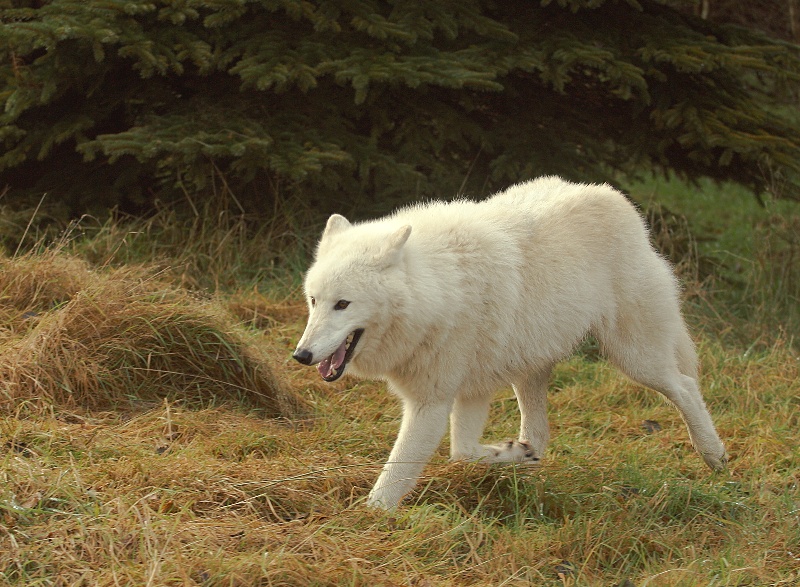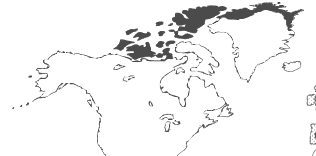- Arctic Wolf
Taxobox
name = Arctic Wolf
status = lc

image_width = 250px
regnum =Animal ia
phylum = Chordata
classis =Mammal ia
ordo =Carnivora
familia =Canidae
genus = "Canis "
species = "C. lupus"
subspecies = "C. l. arctos"
trinomial = "Canis lupus arctos"
trinomial_authority = Pocock, 1935
range_
range_map_width = 250px
range_map_caption = Arctic Wolf rangesThe Arctic Wolf ("Canis lupus arctos"), also called Polar Wolf or White Wolf, is amammal of theCanidae family, and asubspecies of theGray Wolf . Arctic Wolves inhabit theCanadian Arctic and the northern parts ofGreenland .Anatomy
"See also: Gray Wolf behavior and physiology
Arctic Wolves generally are smaller than Gray Wolves, being about convert|3|to|6|ft|m long including the tail; males are larger than females. Their shoulder heights vary from convert|25|to|31|in|cm; Arctic Wolves are bulkier than Gray Wolves, often weighing over convert|100|lb|kg. Weights of up to convert|175|lb|kg have been observed in full-grown males. Arctic Wolves usually have small ears, which help the wolf maintain body heat.
Arctic Wolves have achieved life spans of over 18 years in captivity; however, in the wild, the average lifespan is only 7–10 years.
Hunting
Arctic wolves, like all wolves, hunt in packs; they mostly prey on
Caribou andmusk ox en, but will also kill a number ofArctic Hare s, seals,ptarmigan andlemming s, as well as other smaller animals.Moose are also common prey; their long legs may render them slow and, at times, stuck, in thick snow, leaving them vulnerable to attacks by wolf packs. Due to the scarcity of grazing plants, they roam large areas to find prey up to and beyond convert|2600|km2|sqmi, and they will follow migrating caribou south during the winter. Recent footage filmed by a BBC Wildlife documentary crew shows Arctic wolves huntingwaterfowl . [cite web|last=Morelle|first=Rebecca|url=http://news.bbc.co.uk/1/hi/sci/tech/7213731.stm|title=Elusive wolves caught on camera|publisher=BBC|date=2009-01-31|accessdate=2008-01-31]Reproduction
:"See also: Gray Wolf reproductive physiology and life cycleNormally, only the
alpha male and female breed, but in large packs others may mate as well. Due to the Arctic'spermafrost soil and the difficulty it poses for digging dens, Arctic Wolves often use rock outcroppings, caves or even shallow depressions as dens instead; the mother gives birth to two or three pups in late May to early June, about amonth later than Gray Wolves. It is generally thought that the lower number of pups compared to the average of four to five among Gray Wolves is due to the scarcity of prey in the Arctic. They give birth in about 63 days.Distribution
The Arctic Wolf is the only subspecies of the Gray Wolf that still can be found over the whole of its original range, largely because, in their natural habitat, they rarely encounter humans.
References
* L. David Mech (text), Jim Brandenburg (photos), "At home with the Arctic wolf",
National Geographic Vol. 171 No. 5 (May 1987), pp. 562-593
* L. David Mech, "The Arctic wolf: 10 years with the pack", Voyageur Press 1997, ISBN 0-89658-353-8
*Notes
External links
* [http://www.arctic.noaa.gov/essay_mech.html L. David Mech: Arctic Wolves and Their Prey]
* [http://white-wolf-sanctuary.com/ White Wolf Sanctuary website]
* [http://www.wolf.org/wolves/index.asp Wolf survival website]
* [http://news.bbc.co.uk/2/hi/science/nature/7213731.stm Elusive wolves caught on camera - BBC News]
* [http://www.wolf.org/wolves/learn/basic/wolf_types/inter_gray/arctic.asp International Wolf Center - Artic Wolf Information]
Wikimedia Foundation. 2010.
